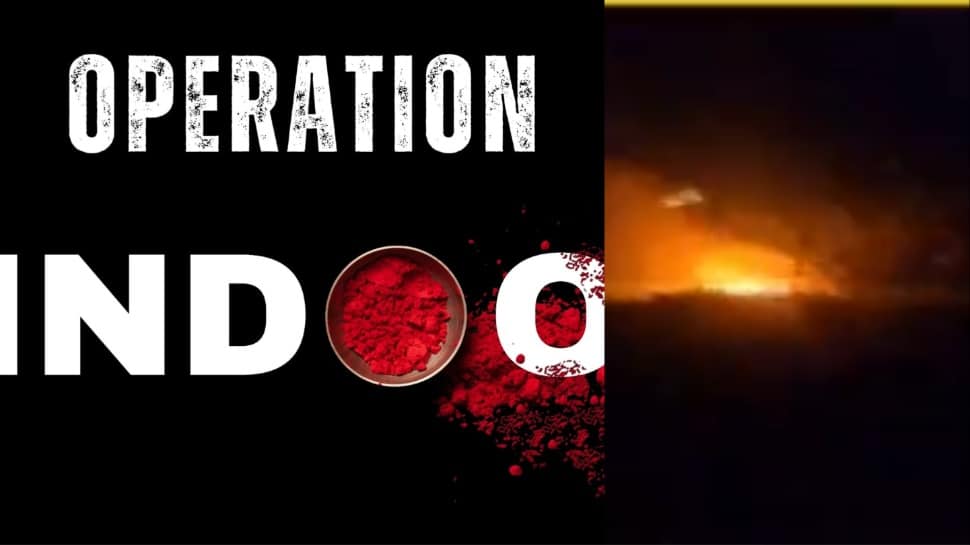Operation Sindoor: In a strong retaliation following the Pahalgam terror attack, the Indian Army early Wednesday launched ‘Operation Sindoor’ and carried out precision airstrikes in PoK and Pakistan and destroyed the terrorism infrastructure of JeM and LeT. In a meticulously planned assault, the Indian Armed Forces demonstrated exceptional coordination while conducting a targeted strike on Pakistani soil.
The operation displayed a well-defined strike ratio, with the Indian Army executing 70 per cent of the attacks and the Indian Air Force taking responsibility for the remaining 30 per cent.
In today’s episode of DNA, ZEE News analysed and explained how the coordinated efforts of the Indian Army, the Indian Air Force and security agencies avenged the Pahalgam terror attack, which claimed the lives of at least 26 people, mostly tourists, and left several others injured.
Watch Full Episode Here
‘ऑपरेशन सिंदूर’ का ‘धमाकेदार’ विश्लेषण
‘हनुमान जी’ जैसा मिशन..25 मिनट में ‘दहन’!
‘मसूद खानदान’ के खात्मे का DNA टेस्टदेखिए #DNA LIVE Rahul Sinha के साथ#ZeeLive #ZeeNews #DNAWithRahulSinha #OperationSindoor #IndianAirForce @RahulSinhaTV https://t.co/DcQcNoBxPZ
— Zee News (@ZeeNews) May 7, 2025
According to ZEE News sources, the operation was carried out with absolute precision and coordinated planning without crossing the international border.
The Indian Air Force played an instrumental role, deploying Rafale fighter jets that launched deadly SCALP and HAMMER missiles — all without crossing the international border. Meanwhile, the Indian Army used indigenous suicide drones to target terrorist hideouts inside Pakistan. The entire operation was, however, not as easy as it seemed. It was planned and executed in five distinct phases:
5 Phases Of Operation Sindoor
Phase 1: Target Selection
Indian military satellites and the intelligence agency RAW gathered critical data from space and on-ground sources. Targets were chosen based on confirmed terrorist presence and training activity, ensuring minimal risk to civilian life.
Phase 2: Target Assessment
Within 15 days, detailed reconnaissance was conducted. RAW collected information on local residents, terrorist movements, and Pakistani military patrols in these areas. The structure and strength of key buildings, such as the Jaish-e-Mohammed headquarters in Bahawalpur, were analysed with precision, right down to the thickness of the concrete roofs.
Phase 3: Weapon Selection
Based on insights from the first two phases, weapons were carefully chosen. For instance, SCALP missiles were selected for their long-range and high-precision capabilities, ideal for destroying fortified structures. These missiles were instrumental in targeting the specific section of the Jaish headquarters where terrorists were located.
Phase 4: Tactical Execution
The military then mapped out the mode of assault for each target. Rafale jets were assigned to attack Bahawalpur, located 100 kilometres from the border. Suicide drones were used to obliterate camps like Sawai Nala and Bilal Camp in Pakistan-occupied Kashmir (PoK).
Phase 5: Timing the Strike
The final phase involved selecting the most strategic time for the attack, post 1 AM, when enemy alertness was at its lowest and terrorists were likely asleep. This timing enabled maximum impact and minimised the possibility of retaliation.
#Operation #Sindoor #Security #Forces #Agencies #Executed #5Phase #Plan #Avenge #Pahalgam #EXPLAINED
Operation Sindoor, Pahalgam Terror Attack, DNA, Airstrikes,Operation Sindoor, Pahalgam Terror Attack, DNA, airstrikes
latest news today, news today, breaking news, latest news today, english news, internet news, top news, oxbig, oxbig news, oxbig news network, oxbig news today, news by oxbig, oxbig media, oxbig network, oxbig news media
HINDI NEWS
News Source



